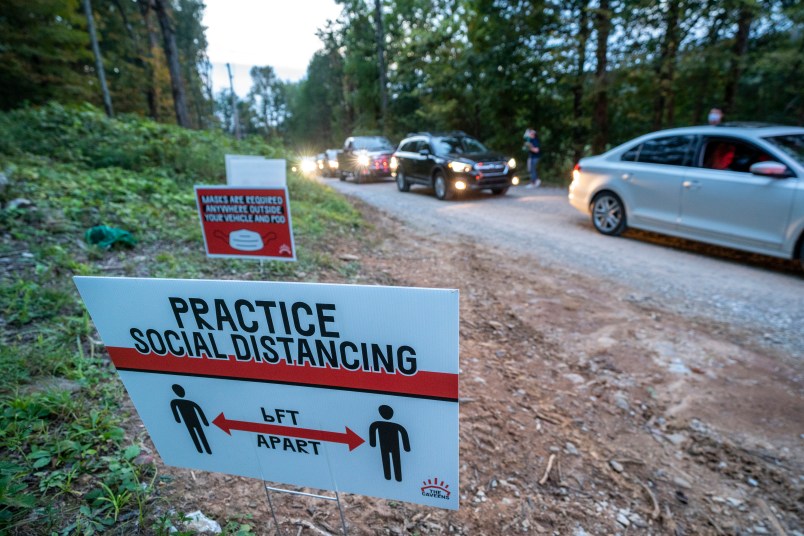This article is part of TPM Cafe, TPM’s home for opinion and news analysis. It is excerpted from “The Hype Machine: How Social Media Disrupts Our Elections, Our Economy, and Our Health — And How We Must Adapt.”
In March 2020, a deliberate misinformation campaign spread fear among the American public by propagating the false story that a nationwide quarantine to contain the coronavirus pandemic was imminent. The National Security Council had to publicly disavow the story. And that wasn’t the only fake news spreading about the virus. The Chinese government spread false conspiracy theories blaming the U.S. military for starting the pandemic.
Several false coronavirus “cures” killed hundreds of people who drank chlorine or excessive alcohol to rid themselves of the virus. There was, of course, no cure or vaccine at the time. International groups, like the World Health Organization (WHO), fought coronavirus misinformation on the Hype Machine as part of their global pandemic response. My group at MIT supported the COVIDConnect fact-checking apparatus, the official WhatsApp coronavirus channel of the WHO, and studied the spread and impact of coronavirus misinformation worldwide. But we first glimpsed the destructive power of health misinformation on the Hype Machine the year before the coronavirus pandemic hit, during the measles resurgence of 2019.
Measles was declared eliminated in the United States in 2000. But while only 63 cases were reported in 2010, over 1,100 cases were reported in the first seven months of 2019, a nearly 1,800 percent increase. Measles is particularly dangerous for kids. It typically starts as a fever and rash, but in one in a thousand cases, it spreads to the brain, causing cranial swelling and convulsions, or encephalitis. In one in twenty kids, it causes pneumonia, preventing the lungs from extracting oxygen from the air and delivering it to the body. The disease took the lives of 110,000 kids worldwide this way in 2017.
Measles is one of the world’s most contagious viruses. You can catch it from droplets of air contaminated with an infected person’s cough hours after they’ve left the room. Nine of ten people exposed to it contract it. While the average number of people infected by one person with the coronavirus of 2020—its R0 figure—was 2.5, the R0 of measles is 15.
To prevent such a contagious disease from spreading, society has to develop herd immunity by vaccinating a large percentage of the population. With polio, which is less contagious, herd immunity can be achieved with 80 to 85 percent vaccination rates. For a highly contagious virus like measles, 95 percent of the population should be vaccinated to achieve herd immunity. Sadly, while there has been an effective vaccine since 1963, the resurgence of measles in the United States was driven by vaccine refusal, according to experts. While 91 percent of young children got the measles-mumps-rubella (or MMR) vaccine in 2017, vaccination rates in some communities fell dramatically in recent years, and it is in exactly these communities that measles skyrocketed.
This outbreak hits close to home for me because I have a six-year-old son, and the hardest-hit group, representing over half of all reported measles cases in the United States in 2019, was the Orthodox Jewish community located five blocks from our home in Brooklyn, New York. Other countrywide outbreaks have been clustered in tight-knit communities like the Jewish community in Rockland County, New York, and the Ukrainian-and Russian-American communities of Clark County, Washington, where vaccination rates hover around 70 percent, well below the threshold needed for herd immunity.
If measles is so dangerous and vaccines are so effective, why are some parents not vaccinating their kids? The answer lies partly in a wave of misinformation about the dangers of vaccination that began in 1998 with a fraudulent paper, published by Andrew Wakefield in the respected medical journal The Lancet, that claimed to link vaccines to autism. It was later revealed that Wakefield had been paid to falsify the evidence in that paper by lawyers suing the vaccine manufacturers, and that he was developing a competing vaccine himself. The Lancet promptly retracted the paper, and Wakefield lost his medical license. But the wave of misinformation he created continues today, aided by conspiracy theories propagated on blogs, in a widely circulated movie called Vaxxed directed by Wakefield himself, and most recently on social media.
In March 2019, addressing this wave of antivax misinformation during a public U.S. Senate hearing, Dr. Jonathan McCullers, chair of the department of pediatrics at the University of Tennessee Health Science Center and pediatrician-in- chief at Le Bonheur Children’s Hospital in Memphis, testified that, in addition to state policies on vaccine exemptions and methods of counseling, “social media and the amplification of minor theories through rapid and diffuse channels of communication, coupled with instant reinforcement in the absence of authoritative opinions, is now driving . . . vaccine hesitancy. When parents get much of their information from the Internet or social media platforms such as Twitter and Facebook, reading these fringe ideas in the absence of accurate information can lead to understandable concern and confusion. These parents may thus be hesitant to get their children vaccinated without more information.” The anecdotal evidence that social media misinformation drives.
Sinan Aral is the David Austin Professor of Management, IT, Marketing and Data Science at MIT, Director of the MIT Initiative on the Digital Economy (IDE) and a founding partner at Manifest Capital. Aral has won the Microsoft Faculty Fellowship, the PopTech Science Fellowship, an NSF CAREER Award, and a Fulbright Scholarship for his research. Aral is a graduate of Northwestern University and holds master’s degrees from the London School of Economics and Harvard University, as well as a PhD from MIT.






